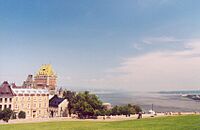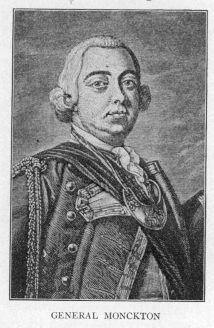Robert Rogers (British Army officer) facts for kids
Quick facts for kids
Robert Rogers
|
|
|---|---|
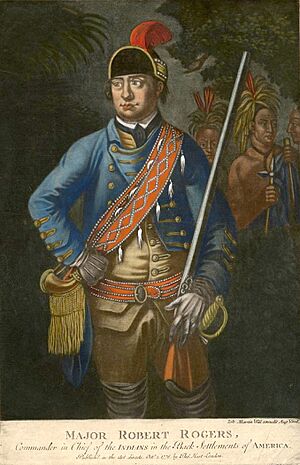
A 1776 coloured mezzotint of Rogers
|
|
| Nickname(s) | Wobomagonda ("White Devil") |
| Born | 7 November 1731 Methuen, Massachusetts |
| Died | 18 May 1795 (aged 63) London, England |
| Allegiance | |
| Service/ |
|
| Rank | Lieutenant-Colonel |
| Unit | Rogers' Rangers Queen's Rangers King's Rangers |
| Battles/wars | |
Robert Rogers (born November 7, 1731 – died May 18, 1795) was a brave British Army officer and explorer. He was born in Methuen, Massachusetts. Rogers fought in three major wars: King George's War, the French and Indian War, and the American Revolutionary War. During the French and Indian War, he created and led a special group called Rogers' Rangers. This unit was trained for unique fighting styles, like surprise attacks and quick movements.
Contents
Early Life and Adventures
Robert Rogers was born on November 7, 1731. His family were settlers from a part of Ireland called Ulster. They lived in Methuen, Massachusetts, a small town. This town was a starting point for many families moving to the wild lands of New Hampshire.
In 1739, when Robert was eight, his family moved. They settled in a place in New Hampshire near what is now Concord. His father started a settlement there. He named it Munterloney, after a hilly area in Ireland. Robert called his home "Mountalona." This place is now known as Dunbarton, New Hampshire.
When Robert was a teenager, a big war started in Europe in 1740. This war, called the War of the Austrian Succession, reached North America in 1744. Here, it was known as King George's War. In 1746, Robert served as a private soldier. He joined the New Hampshire militia. He helped guard the frontier, which was the edge of settled lands.
Fighting in the French and Indian War
In 1755, a new war began between Britain and France. This conflict spread to the American colonies. The British faced many defeats early on. One big loss was at the Battle of the Monongahela. Native American groups, encouraged by French victories, attacked colonial settlements. During this time, a famous soldier named Israel Putnam fought alongside Rogers. Putnam even saved Rogers' life once.

Becoming a Ranger Leader
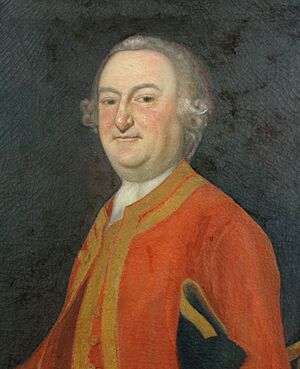
In 1756, Rogers went to Portsmouth, New Hampshire. He started gathering soldiers for the British. Colonel Winslow gave him the power to do this. Many people were scared and angry because of Native American attacks. So, they supported Rogers' efforts to recruit. In Portsmouth, he also met Elizabeth Browne. She was the daughter of a local reverend and later became his wife.
Robert's brothers, James and Richard, also joined Rogers' Rangers. Sadly, Richard died from smallpox in 1757. This happened while they were at Fort William Henry.
Rogers and His Rangers
Rogers created and led the famous Rogers' Rangers. This group fought for the British during the French and Indian War. They mostly operated around Lake George and Lake Champlain in New York. They often went on winter raids against French towns. They used sleds, snowshoes, and even ice skates on frozen rivers.
The British regular army did not always fully respect Rogers' Rangers. However, the Rangers were one of the few groups, besides Native Americans, who could fight well in the harsh winter. They were also skilled in the difficult mountain terrain.
Rogers was very good at leading his unit in tough conditions. He took charge of getting his rangers ready and equipped. He even wrote an early guide for leading such units. This guide is known as Robert Rogers' 28 "Rules of Ranging". Today, the Queen's York Rangers in Canada and the U.S. Army Rangers see Rogers as their founder. His "Standing Orders" are still used in the U.S. Army's Ranger handbook.
Rogers often used his own money to pay his soldiers. He went into deep debt to make sure they were paid. The British Army never fully paid him back for these expenses.
Northern Battles
From 1755 to 1758, Rogers and his rangers served under several British commanders. They fought around Lake Champlain, Crown Point, Ticonderoga, and the upper Hudson River. During this time, the Rangers were vital. Their group grew to twelve companies. They also had Native American allies.
On January 21, 1757, the Rangers fought the First Battle of the Snowshoes. They captured seven Canadians near Fort Carillon. But then they met a larger group of French, Canadian, and Ottawa Native American fighters. Rogers' forces had to retreat.
In August 1757, British forces surrendered Fort William Henry. After this, the Rangers were based on Rogers Island. This was near Fort Edward. This location allowed them to train and operate more freely.
On March 13, 1758, the Rangers fought the Second Battle of the Snowshoes. They attacked a French and Native American group. But then they were ambushed themselves. The Rangers lost many men in this fight.
On July 7, 1758, Rogers' Rangers also took part in the Battle of Carillon.

In 1758, Rogers was promoted to Major. John Stark, another famous soldier, became his second in command. Rogers now held two important ranks.
In 1759, the war started to turn in Britain's favor. The British began to advance on Quebec. Major General Jeffrey Amherst was the new British commander. He sent Rogers and his rangers on a special mission. They went deep into enemy territory. Their target was the Abenaki village of Saint-Francis in Quebec. This village was a base for Native American raids into New England.
Rogers led 200 rangers from Crown Point, New York. They traveled far into French lands to Saint-Francis. The Native Americans there had changed their way of life. They lived in a town next to a French mission. Rogers' forces attacked and destroyed Saint-Francis on October 3, 1759.
During their retreat, the Rangers ran out of food. They were in the wild lands of northern Vermont. They finally reached a safe spot along the Connecticut River. This was at the abandoned Fort Wentworth. Rogers left his men there. He returned a few days later with food and help. This relief came from Fort at Number 4, which is now Charlestown, New Hampshire.
Destroying Saint-Francis was a big victory for the colonists. They no longer felt helpless. The Abenakis and others at Saint-Francis realized they could be reached. Abenaki raids continued, but they became much less frequent.
The Montreal Campaign
Quebec fell in 1759. In the spring of 1760, Rogers joined General Amherst's plan to capture Montreal. First, in June, Rogers led a successful raid on Fort Sainte Thérèse. This was a French supply base. It was also a key link between Fort Saint-Jean and French forces at Île aux Noix.
Rogers then joined William Haviland's advance on Montreal in August. They marched from Lake Ontario along the Saint Lawrence River. They also came from upper New York via the Richelieu River. Rogers helped capture Île aux Noix using a trick. Soon after, the French burned Fort Saint-Jean. Chambly was also taken. The Rangers then led the final march on Montreal. The city surrendered without a fight the next month.
Moving West
After the war in the east ended, Rogers moved on. General Amherst sent him to Brigadier General Robert Monckton. Monckton was in command at Fort Pitt. Following Amherst's advice, Monckton sent the rangers to capture Detroit. They succeeded in taking Detroit.
On November 29, 1760, in Detroit, Rogers received the surrender of French posts. These were located on the Great Lakes. In the spring of 1761, Rogers and his Rangers took over Fort Michilimackinac and Fort St. Joseph. This was the last big action for his command. Soon after, his rangers were disbanded. Rogers then chose to command another company in New York. But that unit was also disbanded quickly. Rogers had to retire with half-pay.
Rogers returned to New England. He married Elizabeth Browne in June 1761. They made their home in Concord, New Hampshire. Like many people then, they had servants and slaves. This included a Native American boy captured at Saint-Francis.
Rogers received large land grants in New Hampshire for his service. He sold much of it for profit. He also bought and kept slaves. He gave a lot of his land to his wife's family. This helped support her later on.
In 1763, the French and Indian War officially ended. This was with the Treaty of Paris. Rogers was still a soldier of fortune, living on half-pay.
Pontiac's War
On May 7, 1763, Pontiac's War began in the Ohio Country. A leader named Pontiac tried to capture Fort Detroit by surprise. He had 300 warriors. But the British commander knew his plan. The fort's soldiers were ready. Pontiac then started a siege of the fort. More than 900 Native American warriors joined the siege.
When Rogers heard this, he offered his help to General Jeffrey Amherst. Rogers then went with Captain James Dalyell. They led a relief force to Fort Detroit. Their mission ended badly at the Battle of Bloody Run on July 31, 1763.
The British tried a surprise attack to break Pontiac's siege. About 250 British troops, led by Dalyell and Rogers, attacked Pontiac's camp. But Pontiac was ready. He defeated the British at Parent's Creek. This creek was said to have run red with blood. It became known as Bloody Run. Captain James Dalyell was killed there.
After these events, Pontiac's war effort weakened. Pontiac himself later disappeared from history. Rogers even wrote a play about Pontiac and the war when he was in England.
Life After the Wars
Rogers had put all his effort into leading the rangers. He often used his own money to pay for their needs. This caused him to go into debt. In 1764, he needed to pay back the people he owed money to.
To earn money, Robert briefly worked with a fur trader near Detroit. When that failed, he tried gambling. This made his financial problems even worse. He was put in prison for debt in New York, but he managed to escape.
Becoming an Author in Britain
In 1765, Rogers sailed to England. He wanted to get paid for his service. He also wanted to use his fame. His personal journals and a book called A Concise Account of North America were published. After that, he wrote a play called Ponteach (1766). This play was important because it was an early American drama. It also showed Native Americans in a positive way. His books had some success, and he even met King George III.
Rogers suggested to the King that he lead an expedition. This trip would try to find the Northwest Passage. This was a sea route through North America to Asia. The King then made Rogers the governor of Fort Michilimackinac (now Mackinaw City, Michigan). He was given permission to look for the passage. So, Rogers returned to North America.
Serving as Royal Governor
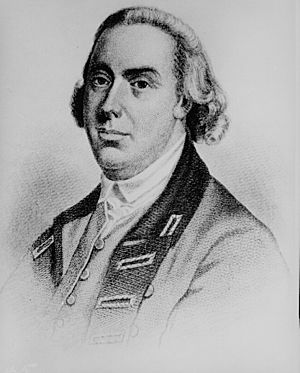
When Rogers came back to America, he moved to Fort Michilimackinac. This was a fur-trading post. He started his job as royal governor. While Rogers was away, Thomas Gage had replaced Amherst as the British commander in America. Gage and Amherst were rivals. Rogers was a loyal friend to Amherst, so Gage disliked him.
Gage saw Rogers as a new person who might challenge his power. Rogers was still a British army captain. So, he was partly under Gage's military command. But Gage couldn't easily remove Rogers, because the King had appointed him. Gage started looking for a good reason to remove Rogers. He wanted to do it in a way that the King couldn't stop.
Rogers didn't know about Gage's plans. He continued his duties with great energy. He sent out expeditions to search for the Northwest Passage. These trips, led by Jonathan Carver and James Tute, were not successful. The path to the Pacific Ocean remained undiscovered.
Rogers believed that the colonies needed to be more united. He also thought they needed a stronger government. He talked with Native American groups and with the French. He even made a plan for a new province in Michigan. This plan would have a governor and a council reporting to the King. King George III supported this idea. But it was unlikely to happen because Parliament did not want the King to have more power.
Meanwhile, Gage tried to make Rogers look bad. He said Rogers was someone who got rich from the war. He also claimed Rogers wasted his money. It's hard to know how much of this was true. Gage seemed to think Rogers was not loyal to him. Rogers' dealings with the Native Americans also worried Gage. Many British officers at the time were very suspicious of Native Americans.
Facing Charges and Clearing His Name
Gage hired spies to read Rogers' mail. He also tried to get Rogers' assistants to turn against him. Rogers upset his private secretary, Nathaniel Potter. Potter then gave Gage the reason he needed. Potter claimed that Rogers had said he would offer his province to the French. This would happen if the British didn't approve his way of governing.
Potter's claims were doubtful. The French were not in a position to take Rogers' offer. Still, based on Potter's statement, Rogers was arrested in 1767. He was charged with treason. He was taken to Montreal in chains for a trial. However, the trial was delayed until 1768. Elizabeth, who was expecting their child, went home to Portsmouth. She gave birth to a son named Arthur. Arthur later became a lawyer and had his own family.

Gage sent Rogers to Montreal for trial. But in Montreal, Rogers had friends who supported Amherst. Because of Amherst's influence, Rogers was found not guilty of all charges. The King approved this decision. However, the King could not openly call Gage a liar. Instead, he noted that there was some reason to think Rogers might have been disloyal.
Returning to Michigan under Gage's power was not an option. So, Rogers went to England in 1769. He again asked for help with his debts. But the King had decided he could not help Rogers anymore. The King was also busy with problems in the American colonies. Rogers again ended up in prison for debt. He tried to sue Gage for false imprisonment. Gage settled the case out of court. He offered Rogers the half-pay of a major if Rogers dropped the lawsuit.
The American Revolutionary War
Because of his legal problems in England, Robert Rogers missed many important events in the colonies. He heard that a revolution might start. So, he returned to America in 1775.
It's not fully clear what happened between Rogers and the revolutionary leaders. Rogers was arrested as a possible spy. He was released on the promise that he would not fight against the colonies. The Continental Congress offered him a position in the Revolutionary Army. But he refused, saying he was a British officer. He later wrote to George Washington asking for a command. Instead, Washington had him arrested.
Rogers escaped from Washington's custody. He found that the revolutionaries were firmly against him. So, he offered his help to the British Army. They hoped he would live up to his reputation. In August 1776, he formed another ranger-style unit. It was called the Queen's Rangers. Rogers was their colonel. In September 1776, Rogers helped capture Nathan Hale. Hale was a spy for the Continental Army. A loyalist shopkeeper named Consider Tiffany wrote about Hale's capture. In his account, Rogers tricked Hale into revealing himself. Rogers pretended to be a patriot spy.
In May 1777, the British Army forced Rogers to retire. They said it was due to "poor health." Going home was now impossible. Hale's execution and Rogers raising troops against the colonists seemed to confirm Washington's suspicions. The New Hampshire legislature passed two orders about Rogers. One banned him from the state. The other divorced him from his wife. She could not show any kindness to Robert if she wanted to stay in New Hampshire. Elizabeth later married an American naval officer. She passed away in 1811.
Later Life and Passing
After a short stay in England, Rogers returned in 1779. He went to Nova Scotia to raise the King's Rangers for General Sir Henry Clinton. He could not keep this position due to his health. So, his brother James took his place. Robert Rogers did not play any further part in the war.
Rogers was captured by an American privateer. He spent some time in a New York prison. He escaped in 1782. In 1783, he was moved to England with other British troops. There, he struggled to earn a living. He passed away in 1795, forgotten and in debt. He was buried in London, but his gravesite is now lost.
Rogers' Lasting Impact
Major Rogers was one of the first people to be inducted into the United States Army Ranger Hall of Fame in 1992. He was honored for his tactics and success as a Ranger. He set the standard for today's U.S. Army Rangers.
Camp Rogers is located at Fort Moore. It is where the Ranger Assessment Phase of U.S. Army Ranger School takes place. It is also the headquarters for the U.S. Army Airborne and Ranger Training Brigade.
On May 30, 2005, a statue of Rogers was revealed. This happened during a ceremony on Rogers Island in the Hudson River. This is near where Rogers wrote his famous "Rules of Ranging."
Rogers is mentioned with respect in "The Ranger Handbook." Every soldier in the U.S. Army's Ranger School receives this book. He is called the creator of ranger tactics in the American military. The Handbook summarizes Rogers' ideas for special warfare.
Methuen High School, in Rogers' hometown, uses "Rangers" as their mascot.
|
See also
- Long-range reconnaissance patrol
- United States Army Rangers



